International Financial Reporting Standards: Lease Accounting
VerifiedAdded on 2021/02/20
|21
|5143
|128
Report
AI Summary
This report delves into the realm of International Financial Reporting Standards (IFRS), specifically focusing on lease accounting. The report begins with an introduction to IFRS and then details the accounting treatments for both lessees and lessors under IAS 16 and IAS 17. It differentiates between finance and operating leases, outlining the specific conditions and rules associated with each type. The report also explores how leases are accounted for in financial statements. Furthermore, the report includes a detailed case study of Royjoy Limited, calculating the implicit interest rate and providing an amortization schedule to illustrate the application of IFRS in practice. The analysis covers the impact of lease accounting on financial statements, providing a comprehensive understanding of the subject.
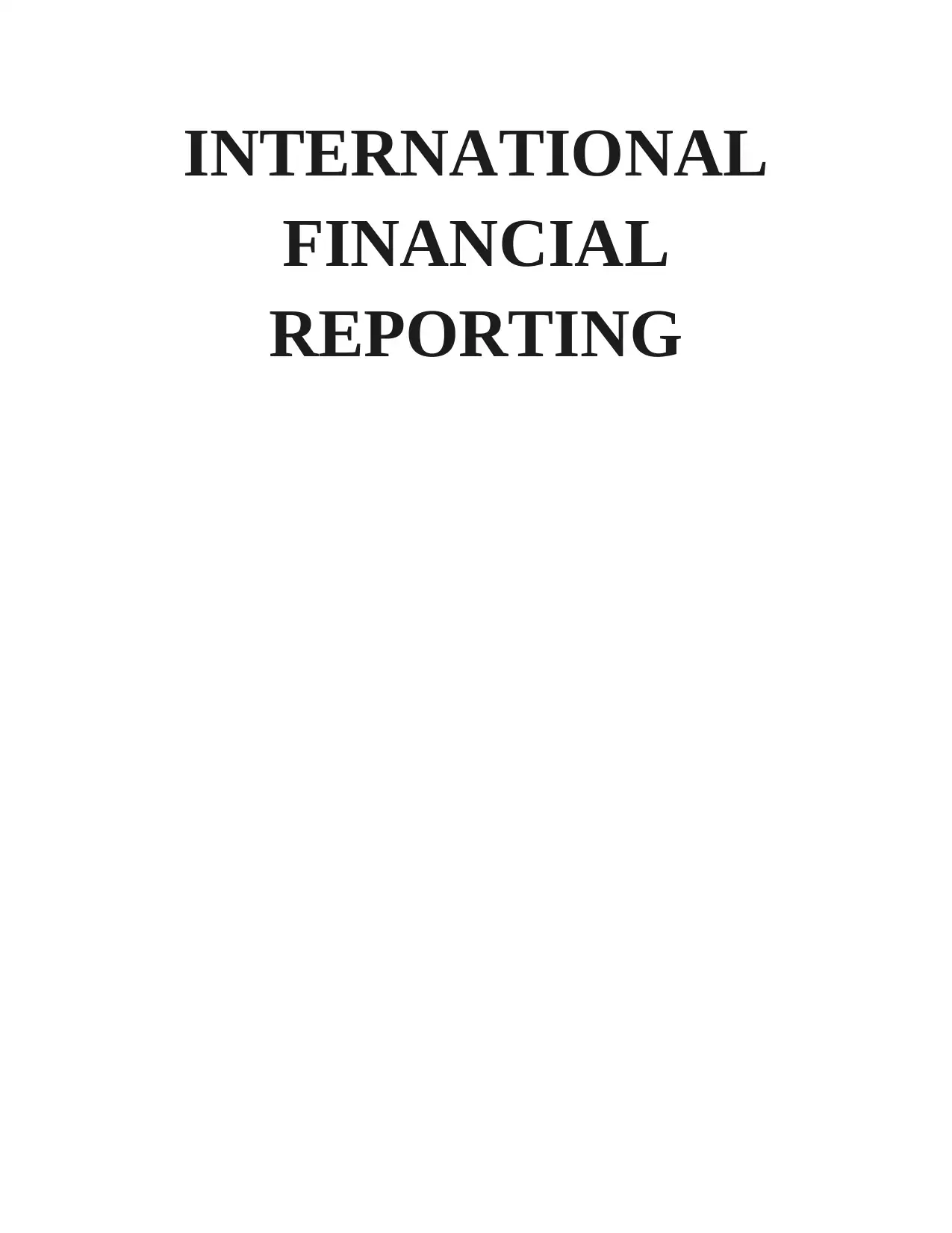
INTERNATIONAL
FINANCIAL
REPORTING
FINANCIAL
REPORTING
Paraphrase This Document
Need a fresh take? Get an instant paraphrase of this document with our AI Paraphraser
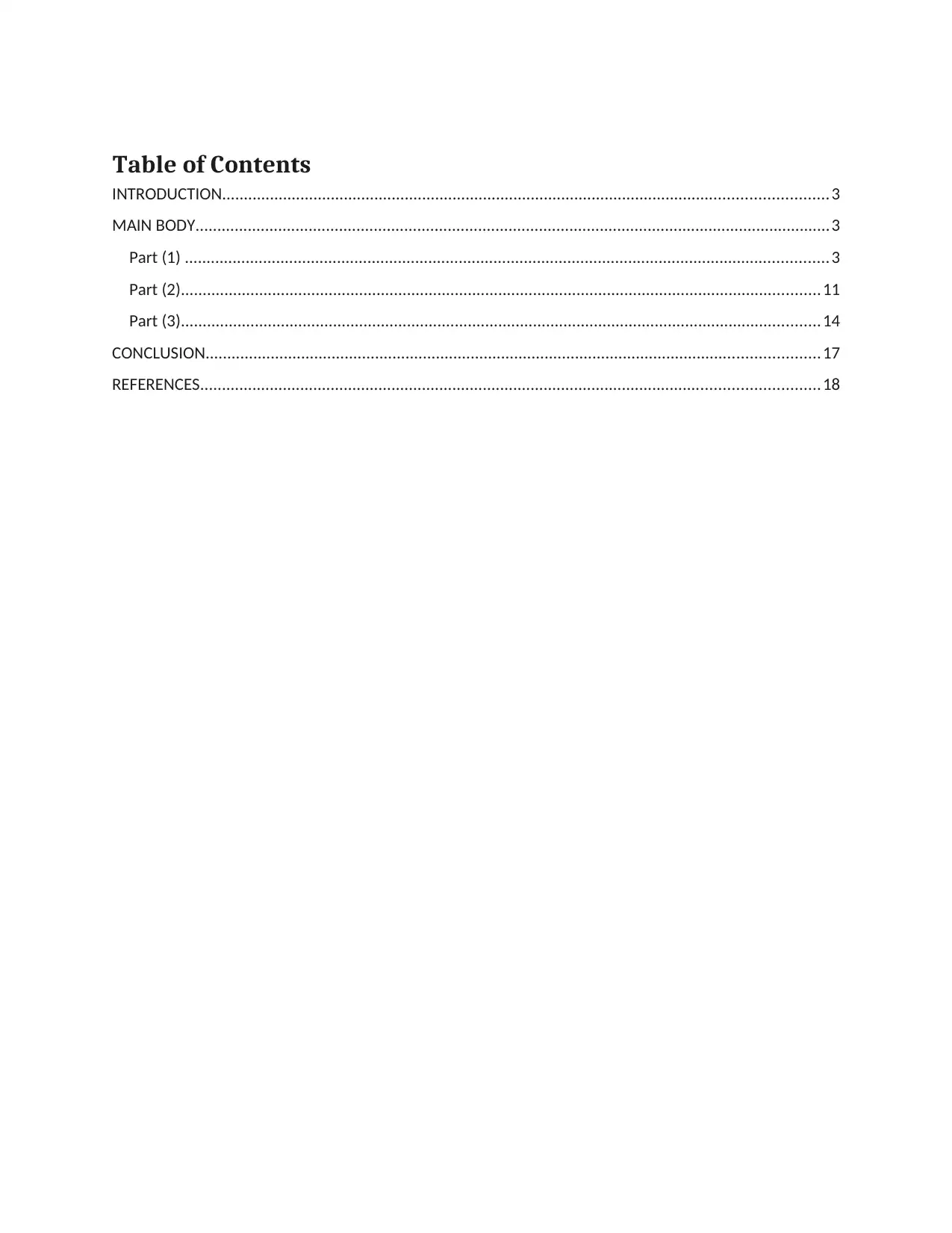
Table of Contents
INTRODUCTION...........................................................................................................................................3
MAIN BODY..................................................................................................................................................3
Part (1) ....................................................................................................................................................3
Part (2)...................................................................................................................................................11
Part (3)...................................................................................................................................................14
CONCLUSION.............................................................................................................................................17
REFERENCES..............................................................................................................................................18
INTRODUCTION...........................................................................................................................................3
MAIN BODY..................................................................................................................................................3
Part (1) ....................................................................................................................................................3
Part (2)...................................................................................................................................................11
Part (3)...................................................................................................................................................14
CONCLUSION.............................................................................................................................................17
REFERENCES..............................................................................................................................................18
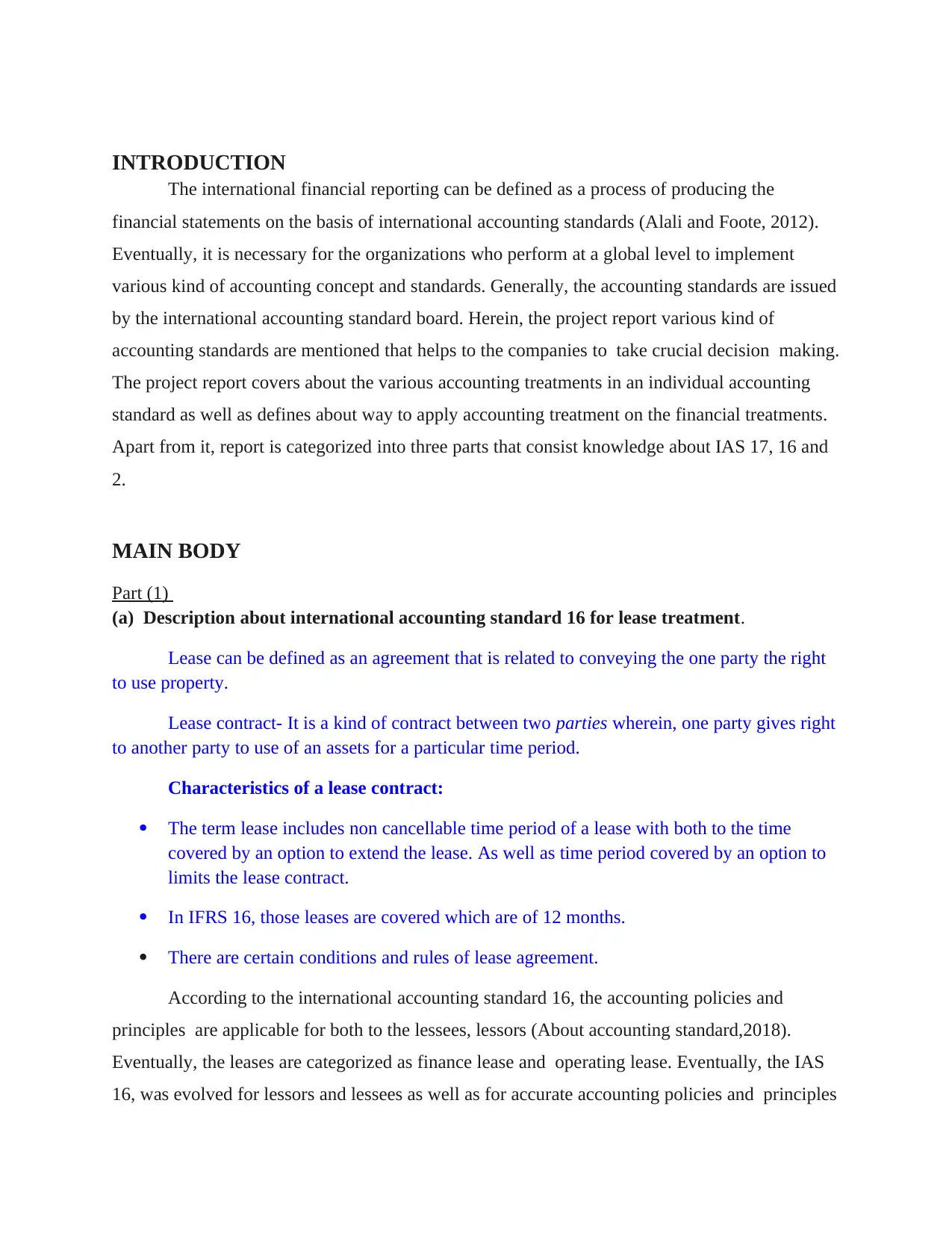
INTRODUCTION
The international financial reporting can be defined as a process of producing the
financial statements on the basis of international accounting standards (Alali and Foote, 2012).
Eventually, it is necessary for the organizations who perform at a global level to implement
various kind of accounting concept and standards. Generally, the accounting standards are issued
by the international accounting standard board. Herein, the project report various kind of
accounting standards are mentioned that helps to the companies to take crucial decision making.
The project report covers about the various accounting treatments in an individual accounting
standard as well as defines about way to apply accounting treatment on the financial treatments.
Apart from it, report is categorized into three parts that consist knowledge about IAS 17, 16 and
2.
MAIN BODY
Part (1)
(a) Description about international accounting standard 16 for lease treatment.
Lease can be defined as an agreement that is related to conveying the one party the right
to use property.
Lease contract- It is a kind of contract between two parties wherein, one party gives right
to another party to use of an assets for a particular time period.
Characteristics of a lease contract:
The term lease includes non cancellable time period of a lease with both to the time
covered by an option to extend the lease. As well as time period covered by an option to
limits the lease contract.
In IFRS 16, those leases are covered which are of 12 months.
There are certain conditions and rules of lease agreement.
According to the international accounting standard 16, the accounting policies and
principles are applicable for both to the lessees, lessors (About accounting standard,2018).
Eventually, the leases are categorized as finance lease and operating lease. Eventually, the IAS
16, was evolved for lessors and lessees as well as for accurate accounting policies and principles
The international financial reporting can be defined as a process of producing the
financial statements on the basis of international accounting standards (Alali and Foote, 2012).
Eventually, it is necessary for the organizations who perform at a global level to implement
various kind of accounting concept and standards. Generally, the accounting standards are issued
by the international accounting standard board. Herein, the project report various kind of
accounting standards are mentioned that helps to the companies to take crucial decision making.
The project report covers about the various accounting treatments in an individual accounting
standard as well as defines about way to apply accounting treatment on the financial treatments.
Apart from it, report is categorized into three parts that consist knowledge about IAS 17, 16 and
2.
MAIN BODY
Part (1)
(a) Description about international accounting standard 16 for lease treatment.
Lease can be defined as an agreement that is related to conveying the one party the right
to use property.
Lease contract- It is a kind of contract between two parties wherein, one party gives right
to another party to use of an assets for a particular time period.
Characteristics of a lease contract:
The term lease includes non cancellable time period of a lease with both to the time
covered by an option to extend the lease. As well as time period covered by an option to
limits the lease contract.
In IFRS 16, those leases are covered which are of 12 months.
There are certain conditions and rules of lease agreement.
According to the international accounting standard 16, the accounting policies and
principles are applicable for both to the lessees, lessors (About accounting standard,2018).
Eventually, the leases are categorized as finance lease and operating lease. Eventually, the IAS
16, was evolved for lessors and lessees as well as for accurate accounting policies and principles
⊘ This is a preview!⊘
Do you want full access?
Subscribe today to unlock all pages.

Trusted by 1+ million students worldwide
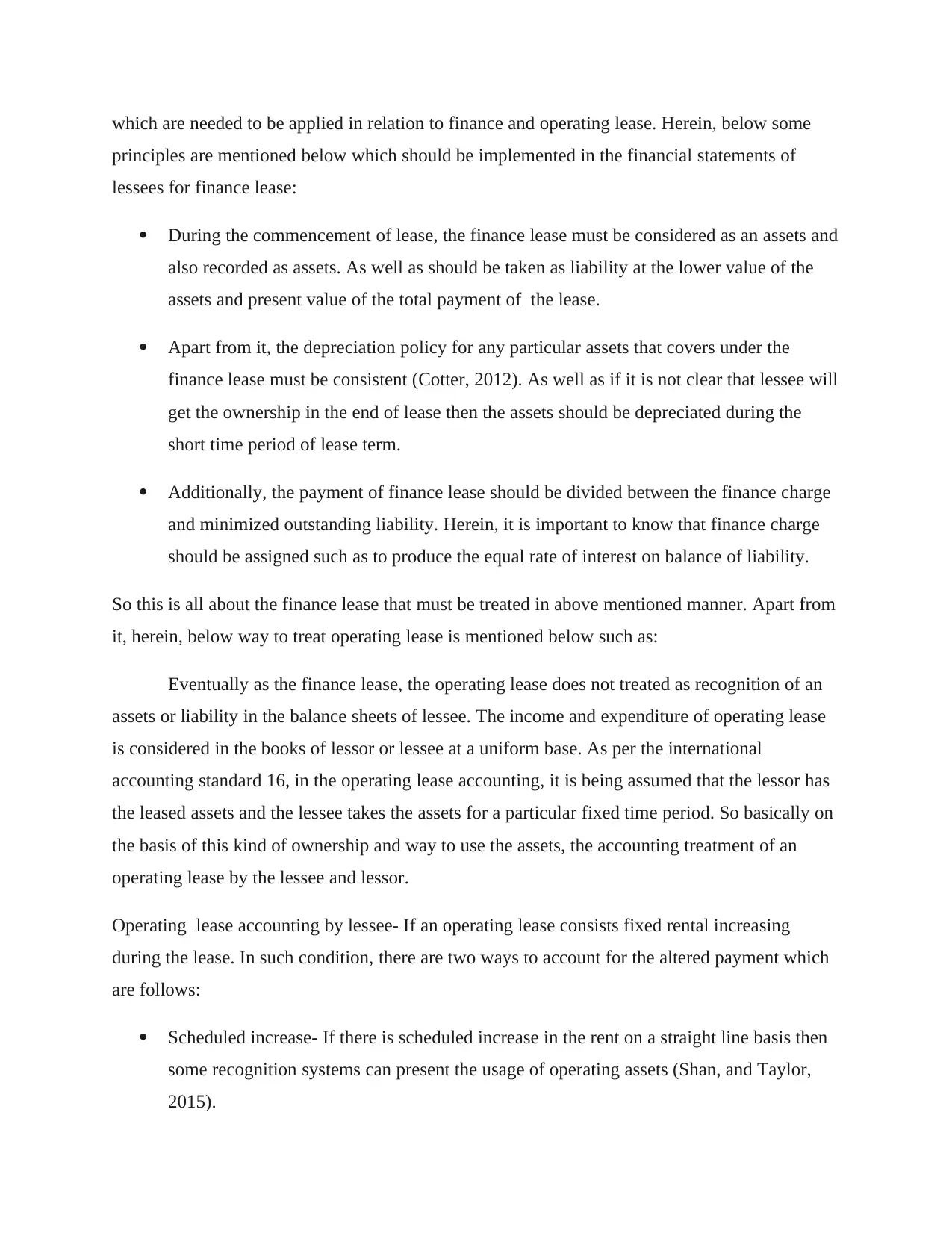
which are needed to be applied in relation to finance and operating lease. Herein, below some
principles are mentioned below which should be implemented in the financial statements of
lessees for finance lease:
During the commencement of lease, the finance lease must be considered as an assets and
also recorded as assets. As well as should be taken as liability at the lower value of the
assets and present value of the total payment of the lease.
Apart from it, the depreciation policy for any particular assets that covers under the
finance lease must be consistent (Cotter, 2012). As well as if it is not clear that lessee will
get the ownership in the end of lease then the assets should be depreciated during the
short time period of lease term.
Additionally, the payment of finance lease should be divided between the finance charge
and minimized outstanding liability. Herein, it is important to know that finance charge
should be assigned such as to produce the equal rate of interest on balance of liability.
So this is all about the finance lease that must be treated in above mentioned manner. Apart from
it, herein, below way to treat operating lease is mentioned below such as:
Eventually as the finance lease, the operating lease does not treated as recognition of an
assets or liability in the balance sheets of lessee. The income and expenditure of operating lease
is considered in the books of lessor or lessee at a uniform base. As per the international
accounting standard 16, in the operating lease accounting, it is being assumed that the lessor has
the leased assets and the lessee takes the assets for a particular fixed time period. So basically on
the basis of this kind of ownership and way to use the assets, the accounting treatment of an
operating lease by the lessee and lessor.
Operating lease accounting by lessee- If an operating lease consists fixed rental increasing
during the lease. In such condition, there are two ways to account for the altered payment which
are follows:
Scheduled increase- If there is scheduled increase in the rent on a straight line basis then
some recognition systems can present the usage of operating assets (Shan, and Taylor,
2015).
principles are mentioned below which should be implemented in the financial statements of
lessees for finance lease:
During the commencement of lease, the finance lease must be considered as an assets and
also recorded as assets. As well as should be taken as liability at the lower value of the
assets and present value of the total payment of the lease.
Apart from it, the depreciation policy for any particular assets that covers under the
finance lease must be consistent (Cotter, 2012). As well as if it is not clear that lessee will
get the ownership in the end of lease then the assets should be depreciated during the
short time period of lease term.
Additionally, the payment of finance lease should be divided between the finance charge
and minimized outstanding liability. Herein, it is important to know that finance charge
should be assigned such as to produce the equal rate of interest on balance of liability.
So this is all about the finance lease that must be treated in above mentioned manner. Apart from
it, herein, below way to treat operating lease is mentioned below such as:
Eventually as the finance lease, the operating lease does not treated as recognition of an
assets or liability in the balance sheets of lessee. The income and expenditure of operating lease
is considered in the books of lessor or lessee at a uniform base. As per the international
accounting standard 16, in the operating lease accounting, it is being assumed that the lessor has
the leased assets and the lessee takes the assets for a particular fixed time period. So basically on
the basis of this kind of ownership and way to use the assets, the accounting treatment of an
operating lease by the lessee and lessor.
Operating lease accounting by lessee- If an operating lease consists fixed rental increasing
during the lease. In such condition, there are two ways to account for the altered payment which
are follows:
Scheduled increase- If there is scheduled increase in the rent on a straight line basis then
some recognition systems can present the usage of operating assets (Shan, and Taylor,
2015).
Paraphrase This Document
Need a fresh take? Get an instant paraphrase of this document with our AI Paraphraser
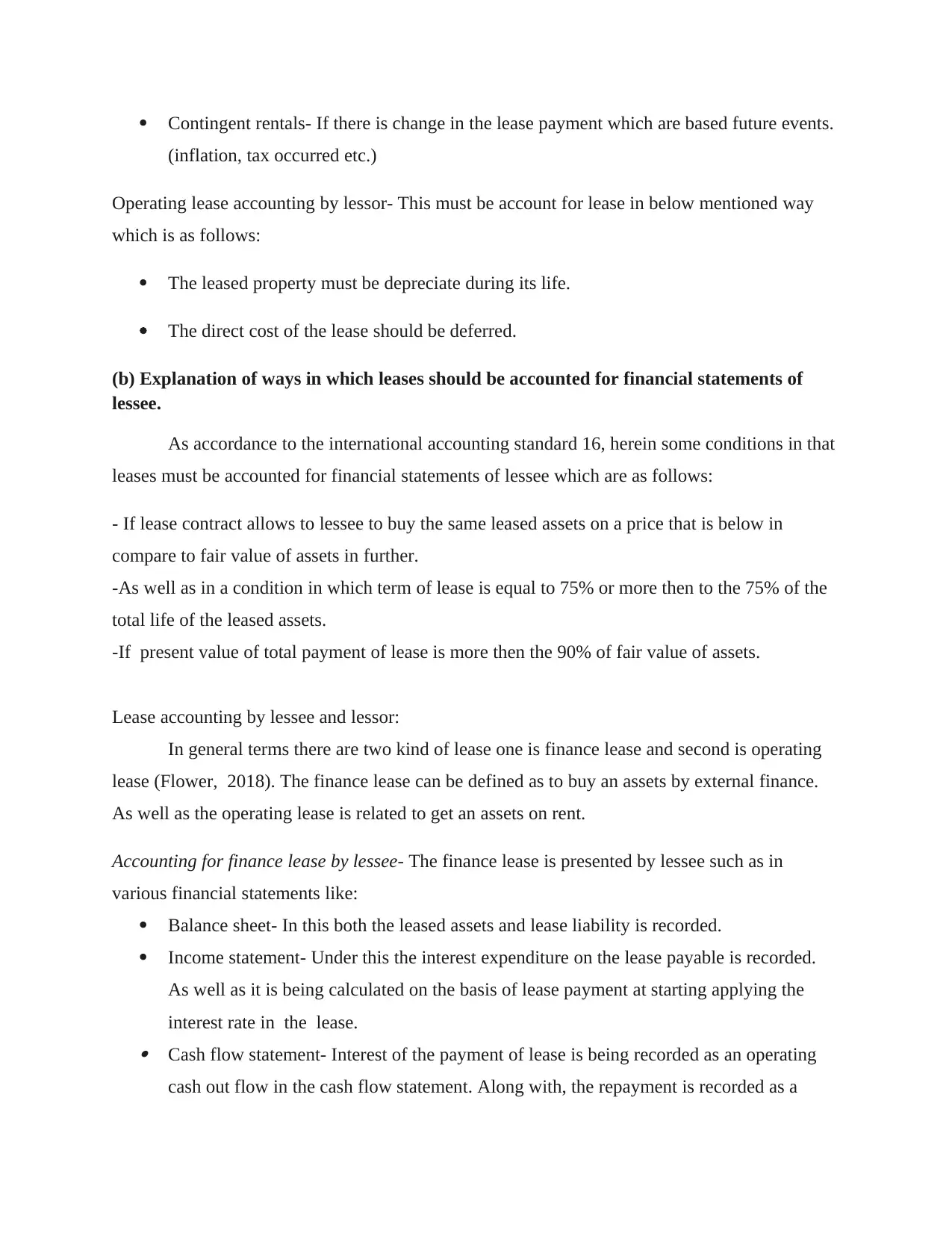
Contingent rentals- If there is change in the lease payment which are based future events.
(inflation, tax occurred etc.)
Operating lease accounting by lessor- This must be account for lease in below mentioned way
which is as follows:
The leased property must be depreciate during its life.
The direct cost of the lease should be deferred.
(b) Explanation of ways in which leases should be accounted for financial statements of
lessee.
As accordance to the international accounting standard 16, herein some conditions in that
leases must be accounted for financial statements of lessee which are as follows:
- If lease contract allows to lessee to buy the same leased assets on a price that is below in
compare to fair value of assets in further.
-As well as in a condition in which term of lease is equal to 75% or more then to the 75% of the
total life of the leased assets.
-If present value of total payment of lease is more then the 90% of fair value of assets.
Lease accounting by lessee and lessor:
In general terms there are two kind of lease one is finance lease and second is operating
lease (Flower, 2018). The finance lease can be defined as to buy an assets by external finance.
As well as the operating lease is related to get an assets on rent.
Accounting for finance lease by lessee- The finance lease is presented by lessee such as in
various financial statements like:
Balance sheet- In this both the leased assets and lease liability is recorded.
Income statement- Under this the interest expenditure on the lease payable is recorded.
As well as it is being calculated on the basis of lease payment at starting applying the
interest rate in the lease. Cash flow statement- Interest of the payment of lease is being recorded as an operating
cash out flow in the cash flow statement. Along with, the repayment is recorded as a
(inflation, tax occurred etc.)
Operating lease accounting by lessor- This must be account for lease in below mentioned way
which is as follows:
The leased property must be depreciate during its life.
The direct cost of the lease should be deferred.
(b) Explanation of ways in which leases should be accounted for financial statements of
lessee.
As accordance to the international accounting standard 16, herein some conditions in that
leases must be accounted for financial statements of lessee which are as follows:
- If lease contract allows to lessee to buy the same leased assets on a price that is below in
compare to fair value of assets in further.
-As well as in a condition in which term of lease is equal to 75% or more then to the 75% of the
total life of the leased assets.
-If present value of total payment of lease is more then the 90% of fair value of assets.
Lease accounting by lessee and lessor:
In general terms there are two kind of lease one is finance lease and second is operating
lease (Flower, 2018). The finance lease can be defined as to buy an assets by external finance.
As well as the operating lease is related to get an assets on rent.
Accounting for finance lease by lessee- The finance lease is presented by lessee such as in
various financial statements like:
Balance sheet- In this both the leased assets and lease liability is recorded.
Income statement- Under this the interest expenditure on the lease payable is recorded.
As well as it is being calculated on the basis of lease payment at starting applying the
interest rate in the lease. Cash flow statement- Interest of the payment of lease is being recorded as an operating
cash out flow in the cash flow statement. Along with, the repayment is recorded as a
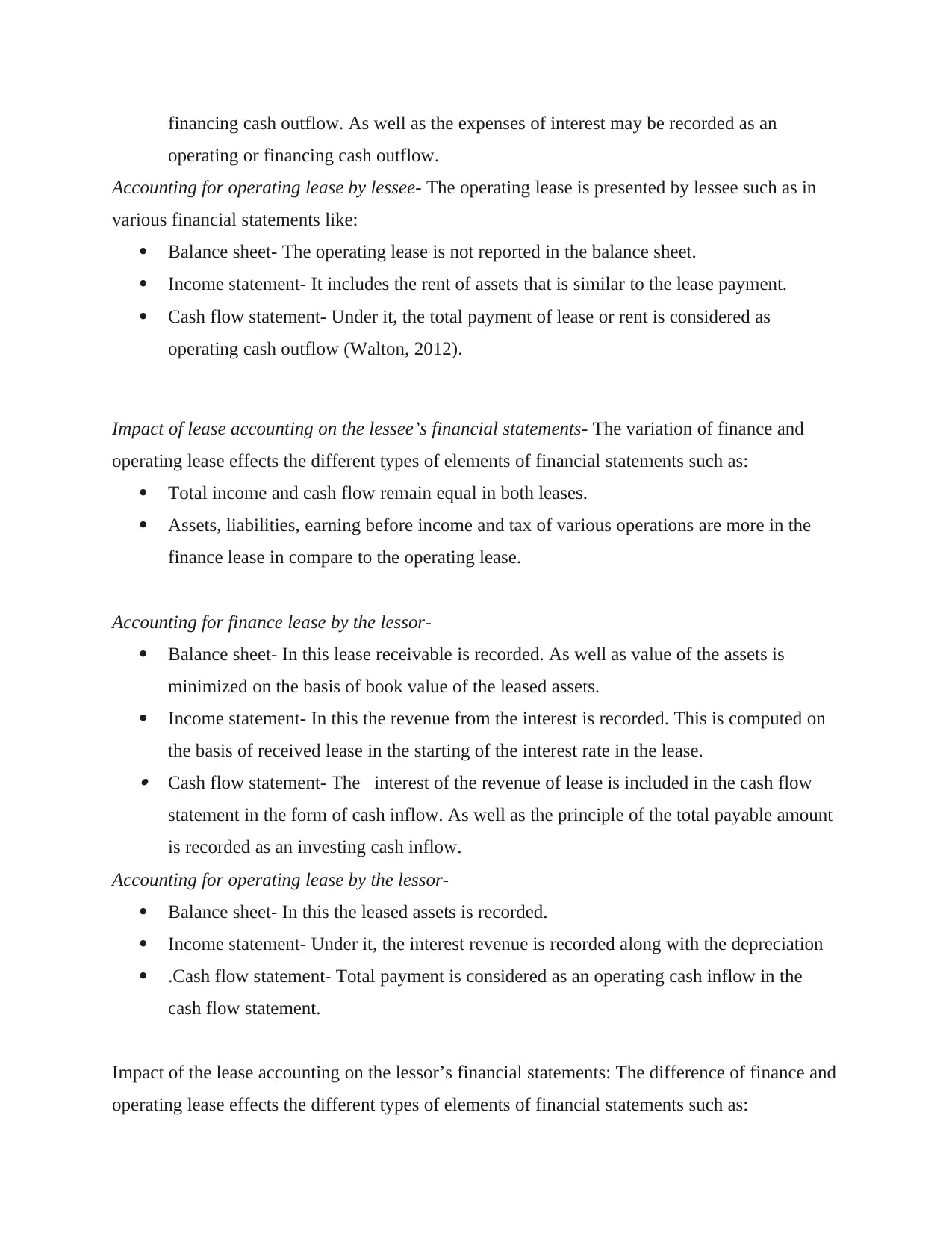
financing cash outflow. As well as the expenses of interest may be recorded as an
operating or financing cash outflow.
Accounting for operating lease by lessee- The operating lease is presented by lessee such as in
various financial statements like:
Balance sheet- The operating lease is not reported in the balance sheet.
Income statement- It includes the rent of assets that is similar to the lease payment.
Cash flow statement- Under it, the total payment of lease or rent is considered as
operating cash outflow (Walton, 2012).
Impact of lease accounting on the lessee’s financial statements- The variation of finance and
operating lease effects the different types of elements of financial statements such as:
Total income and cash flow remain equal in both leases.
Assets, liabilities, earning before income and tax of various operations are more in the
finance lease in compare to the operating lease.
Accounting for finance lease by the lessor-
Balance sheet- In this lease receivable is recorded. As well as value of the assets is
minimized on the basis of book value of the leased assets.
Income statement- In this the revenue from the interest is recorded. This is computed on
the basis of received lease in the starting of the interest rate in the lease. Cash flow statement- The interest of the revenue of lease is included in the cash flow
statement in the form of cash inflow. As well as the principle of the total payable amount
is recorded as an investing cash inflow.
Accounting for operating lease by the lessor-
Balance sheet- In this the leased assets is recorded.
Income statement- Under it, the interest revenue is recorded along with the depreciation
.Cash flow statement- Total payment is considered as an operating cash inflow in the
cash flow statement.
Impact of the lease accounting on the lessor’s financial statements: The difference of finance and
operating lease effects the different types of elements of financial statements such as:
operating or financing cash outflow.
Accounting for operating lease by lessee- The operating lease is presented by lessee such as in
various financial statements like:
Balance sheet- The operating lease is not reported in the balance sheet.
Income statement- It includes the rent of assets that is similar to the lease payment.
Cash flow statement- Under it, the total payment of lease or rent is considered as
operating cash outflow (Walton, 2012).
Impact of lease accounting on the lessee’s financial statements- The variation of finance and
operating lease effects the different types of elements of financial statements such as:
Total income and cash flow remain equal in both leases.
Assets, liabilities, earning before income and tax of various operations are more in the
finance lease in compare to the operating lease.
Accounting for finance lease by the lessor-
Balance sheet- In this lease receivable is recorded. As well as value of the assets is
minimized on the basis of book value of the leased assets.
Income statement- In this the revenue from the interest is recorded. This is computed on
the basis of received lease in the starting of the interest rate in the lease. Cash flow statement- The interest of the revenue of lease is included in the cash flow
statement in the form of cash inflow. As well as the principle of the total payable amount
is recorded as an investing cash inflow.
Accounting for operating lease by the lessor-
Balance sheet- In this the leased assets is recorded.
Income statement- Under it, the interest revenue is recorded along with the depreciation
.Cash flow statement- Total payment is considered as an operating cash inflow in the
cash flow statement.
Impact of the lease accounting on the lessor’s financial statements: The difference of finance and
operating lease effects the different types of elements of financial statements such as:
⊘ This is a preview!⊘
Do you want full access?
Subscribe today to unlock all pages.

Trusted by 1+ million students worldwide
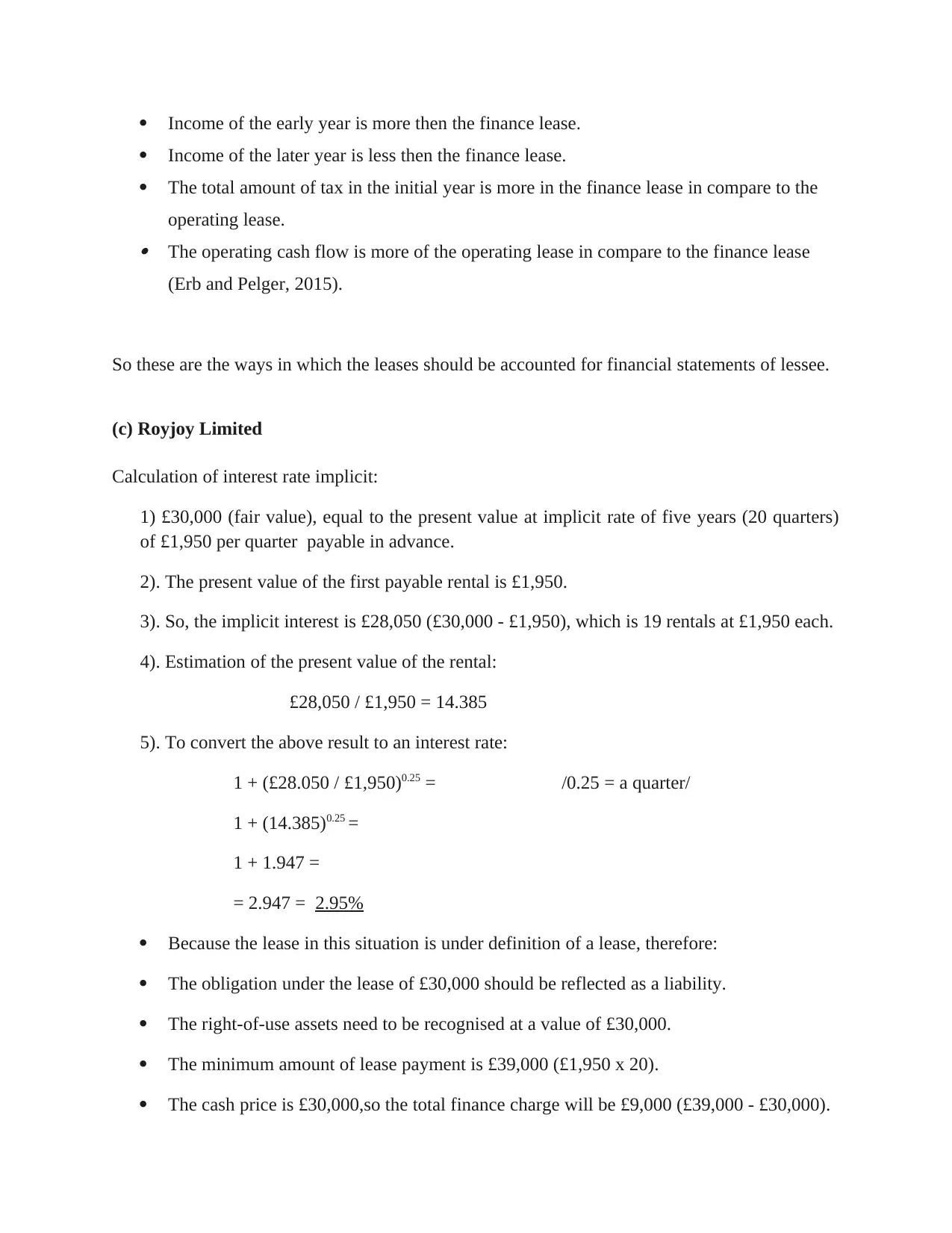
Income of the early year is more then the finance lease.
Income of the later year is less then the finance lease.
The total amount of tax in the initial year is more in the finance lease in compare to the
operating lease. The operating cash flow is more of the operating lease in compare to the finance lease
(Erb and Pelger, 2015).
So these are the ways in which the leases should be accounted for financial statements of lessee.
(c) Royjoy Limited
Calculation of interest rate implicit:
1) £30,000 (fair value), equal to the present value at implicit rate of five years (20 quarters)
of £1,950 per quarter payable in advance.
2). The present value of the first payable rental is £1,950.
3). So, the implicit interest is £28,050 (£30,000 - £1,950), which is 19 rentals at £1,950 each.
4). Estimation of the present value of the rental:
£28,050 / £1,950 = 14.385
5). To convert the above result to an interest rate:
1 + (£28.050 / £1,950)0.25 = /0.25 = a quarter/
1 + (14.385)0.25 =
1 + 1.947 =
= 2.947 = 2.95%
Because the lease in this situation is under definition of a lease, therefore:
The obligation under the lease of £30,000 should be reflected as a liability.
The right-of-use assets need to be recognised at a value of £30,000.
The minimum amount of lease payment is £39,000 (£1,950 x 20).
The cash price is £30,000,so the total finance charge will be £9,000 (£39,000 - £30,000).
Income of the later year is less then the finance lease.
The total amount of tax in the initial year is more in the finance lease in compare to the
operating lease. The operating cash flow is more of the operating lease in compare to the finance lease
(Erb and Pelger, 2015).
So these are the ways in which the leases should be accounted for financial statements of lessee.
(c) Royjoy Limited
Calculation of interest rate implicit:
1) £30,000 (fair value), equal to the present value at implicit rate of five years (20 quarters)
of £1,950 per quarter payable in advance.
2). The present value of the first payable rental is £1,950.
3). So, the implicit interest is £28,050 (£30,000 - £1,950), which is 19 rentals at £1,950 each.
4). Estimation of the present value of the rental:
£28,050 / £1,950 = 14.385
5). To convert the above result to an interest rate:
1 + (£28.050 / £1,950)0.25 = /0.25 = a quarter/
1 + (14.385)0.25 =
1 + 1.947 =
= 2.947 = 2.95%
Because the lease in this situation is under definition of a lease, therefore:
The obligation under the lease of £30,000 should be reflected as a liability.
The right-of-use assets need to be recognised at a value of £30,000.
The minimum amount of lease payment is £39,000 (£1,950 x 20).
The cash price is £30,000,so the total finance charge will be £9,000 (£39,000 - £30,000).
Paraphrase This Document
Need a fresh take? Get an instant paraphrase of this document with our AI Paraphraser
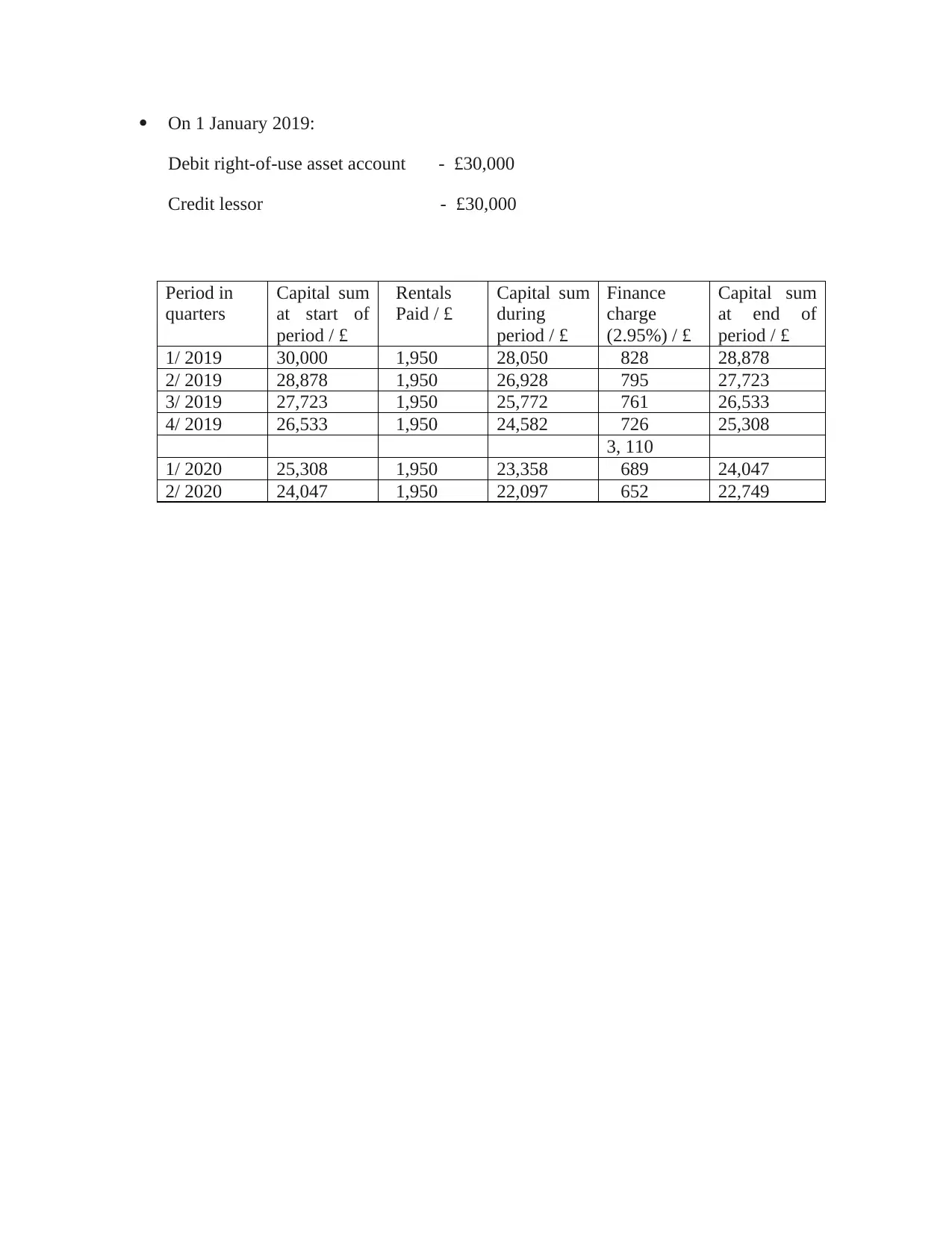
On 1 January 2019:
Debit right-of-use asset account - £30,000
Credit lessor - £30,000
Period in
quarters
Capital sum
at start of
period / £
Rentals
Paid / £
Capital sum
during
period / £
Finance
charge
(2.95%) / £
Capital sum
at end of
period / £
1/ 2019 30,000 1,950 28,050 828 28,878
2/ 2019 28,878 1,950 26,928 795 27,723
3/ 2019 27,723 1,950 25,772 761 26,533
4/ 2019 26,533 1,950 24,582 726 25,308
3, 110
1/ 2020 25,308 1,950 23,358 689 24,047
2/ 2020 24,047 1,950 22,097 652 22,749
Debit right-of-use asset account - £30,000
Credit lessor - £30,000
Period in
quarters
Capital sum
at start of
period / £
Rentals
Paid / £
Capital sum
during
period / £
Finance
charge
(2.95%) / £
Capital sum
at end of
period / £
1/ 2019 30,000 1,950 28,050 828 28,878
2/ 2019 28,878 1,950 26,928 795 27,723
3/ 2019 27,723 1,950 25,772 761 26,533
4/ 2019 26,533 1,950 24,582 726 25,308
3, 110
1/ 2020 25,308 1,950 23,358 689 24,047
2/ 2020 24,047 1,950 22,097 652 22,749
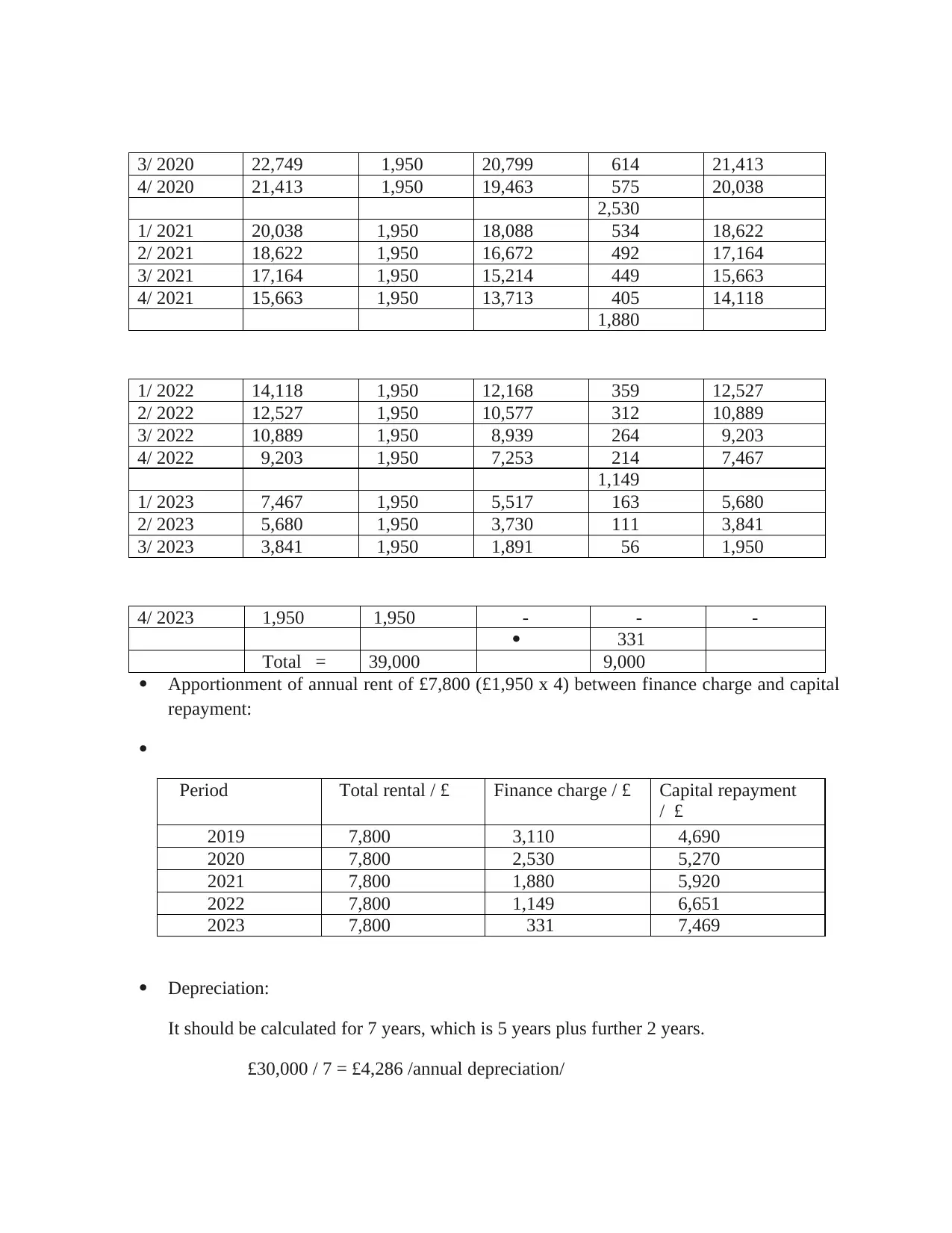
3/ 2020 22,749 1,950 20,799 614 21,413
4/ 2020 21,413 1,950 19,463 575 20,038
2,530
1/ 2021 20,038 1,950 18,088 534 18,622
2/ 2021 18,622 1,950 16,672 492 17,164
3/ 2021 17,164 1,950 15,214 449 15,663
4/ 2021 15,663 1,950 13,713 405 14,118
1,880
1/ 2022 14,118 1,950 12,168 359 12,527
2/ 2022 12,527 1,950 10,577 312 10,889
3/ 2022 10,889 1,950 8,939 264 9,203
4/ 2022 9,203 1,950 7,253 214 7,467
1,149
1/ 2023 7,467 1,950 5,517 163 5,680
2/ 2023 5,680 1,950 3,730 111 3,841
3/ 2023 3,841 1,950 1,891 56 1,950
4/ 2023 1,950 1,950 - - -
331
Total = 39,000 9,000
Apportionment of annual rent of £7,800 (£1,950 x 4) between finance charge and capital
repayment:
Period Total rental / £ Finance charge / £ Capital repayment
/ £
2019 7,800 3,110 4,690
2020 7,800 2,530 5,270
2021 7,800 1,880 5,920
2022 7,800 1,149 6,651
2023 7,800 331 7,469
Depreciation:
It should be calculated for 7 years, which is 5 years plus further 2 years.
£30,000 / 7 = £4,286 /annual depreciation/
4/ 2020 21,413 1,950 19,463 575 20,038
2,530
1/ 2021 20,038 1,950 18,088 534 18,622
2/ 2021 18,622 1,950 16,672 492 17,164
3/ 2021 17,164 1,950 15,214 449 15,663
4/ 2021 15,663 1,950 13,713 405 14,118
1,880
1/ 2022 14,118 1,950 12,168 359 12,527
2/ 2022 12,527 1,950 10,577 312 10,889
3/ 2022 10,889 1,950 8,939 264 9,203
4/ 2022 9,203 1,950 7,253 214 7,467
1,149
1/ 2023 7,467 1,950 5,517 163 5,680
2/ 2023 5,680 1,950 3,730 111 3,841
3/ 2023 3,841 1,950 1,891 56 1,950
4/ 2023 1,950 1,950 - - -
331
Total = 39,000 9,000
Apportionment of annual rent of £7,800 (£1,950 x 4) between finance charge and capital
repayment:
Period Total rental / £ Finance charge / £ Capital repayment
/ £
2019 7,800 3,110 4,690
2020 7,800 2,530 5,270
2021 7,800 1,880 5,920
2022 7,800 1,149 6,651
2023 7,800 331 7,469
Depreciation:
It should be calculated for 7 years, which is 5 years plus further 2 years.
£30,000 / 7 = £4,286 /annual depreciation/
⊘ This is a preview!⊘
Do you want full access?
Subscribe today to unlock all pages.

Trusted by 1+ million students worldwide
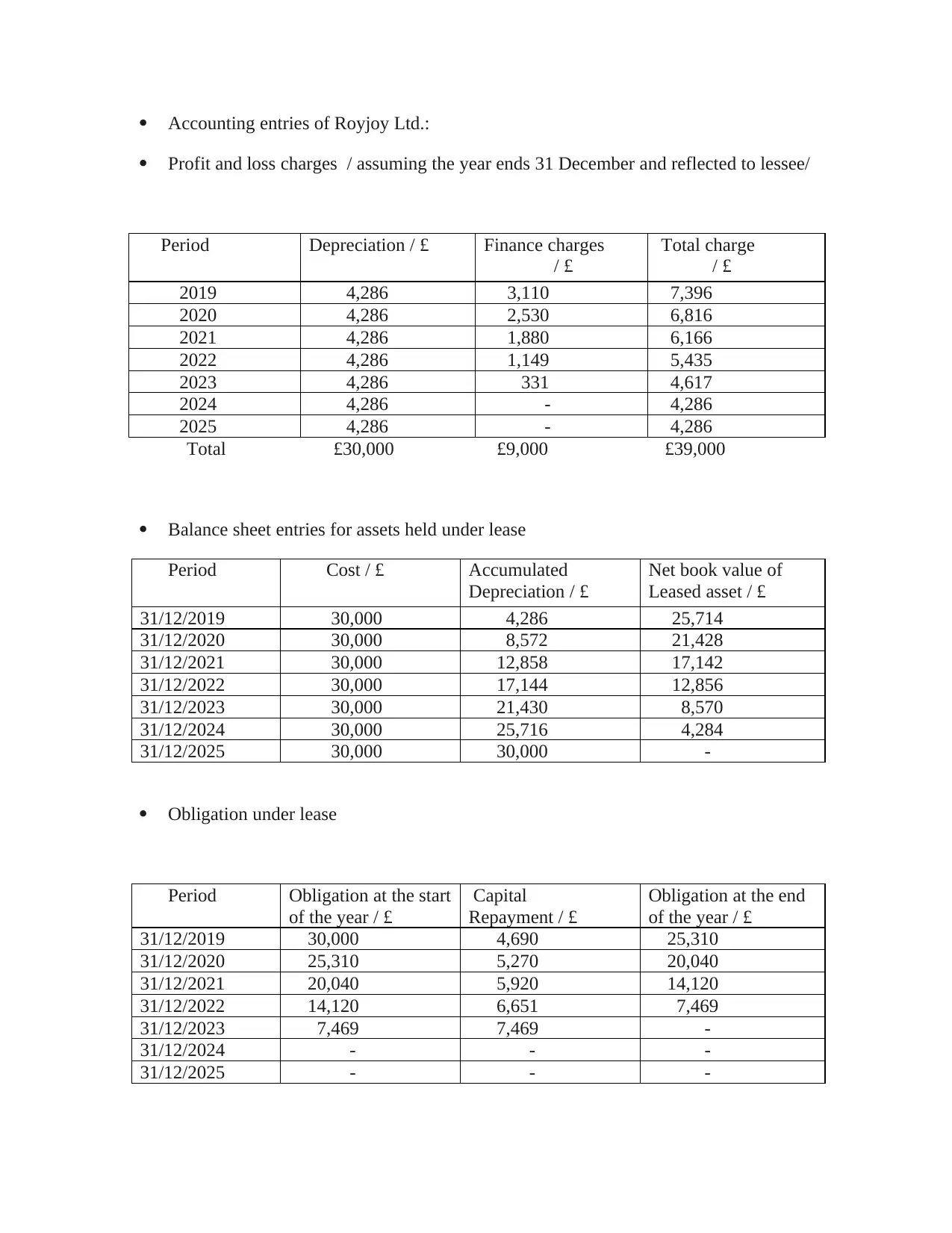
Accounting entries of Royjoy Ltd.:
Profit and loss charges / assuming the year ends 31 December and reflected to lessee/
Period Depreciation / £ Finance charges
/ £
Total charge
/ £
2019 4,286 3,110 7,396
2020 4,286 2,530 6,816
2021 4,286 1,880 6,166
2022 4,286 1,149 5,435
2023 4,286 331 4,617
2024 4,286 - 4,286
2025 4,286 - 4,286
Total £30,000 £9,000 £39,000
Balance sheet entries for assets held under lease
Period Cost / £ Accumulated
Depreciation / £
Net book value of
Leased asset / £
31/12/2019 30,000 4,286 25,714
31/12/2020 30,000 8,572 21,428
31/12/2021 30,000 12,858 17,142
31/12/2022 30,000 17,144 12,856
31/12/2023 30,000 21,430 8,570
31/12/2024 30,000 25,716 4,284
31/12/2025 30,000 30,000 -
Obligation under lease
Period Obligation at the start
of the year / £
Capital
Repayment / £
Obligation at the end
of the year / £
31/12/2019 30,000 4,690 25,310
31/12/2020 25,310 5,270 20,040
31/12/2021 20,040 5,920 14,120
31/12/2022 14,120 6,651 7,469
31/12/2023 7,469 7,469 -
31/12/2024 - - -
31/12/2025 - - -
Profit and loss charges / assuming the year ends 31 December and reflected to lessee/
Period Depreciation / £ Finance charges
/ £
Total charge
/ £
2019 4,286 3,110 7,396
2020 4,286 2,530 6,816
2021 4,286 1,880 6,166
2022 4,286 1,149 5,435
2023 4,286 331 4,617
2024 4,286 - 4,286
2025 4,286 - 4,286
Total £30,000 £9,000 £39,000
Balance sheet entries for assets held under lease
Period Cost / £ Accumulated
Depreciation / £
Net book value of
Leased asset / £
31/12/2019 30,000 4,286 25,714
31/12/2020 30,000 8,572 21,428
31/12/2021 30,000 12,858 17,142
31/12/2022 30,000 17,144 12,856
31/12/2023 30,000 21,430 8,570
31/12/2024 30,000 25,716 4,284
31/12/2025 30,000 30,000 -
Obligation under lease
Period Obligation at the start
of the year / £
Capital
Repayment / £
Obligation at the end
of the year / £
31/12/2019 30,000 4,690 25,310
31/12/2020 25,310 5,270 20,040
31/12/2021 20,040 5,920 14,120
31/12/2022 14,120 6,651 7,469
31/12/2023 7,469 7,469 -
31/12/2024 - - -
31/12/2025 - - -
Paraphrase This Document
Need a fresh take? Get an instant paraphrase of this document with our AI Paraphraser
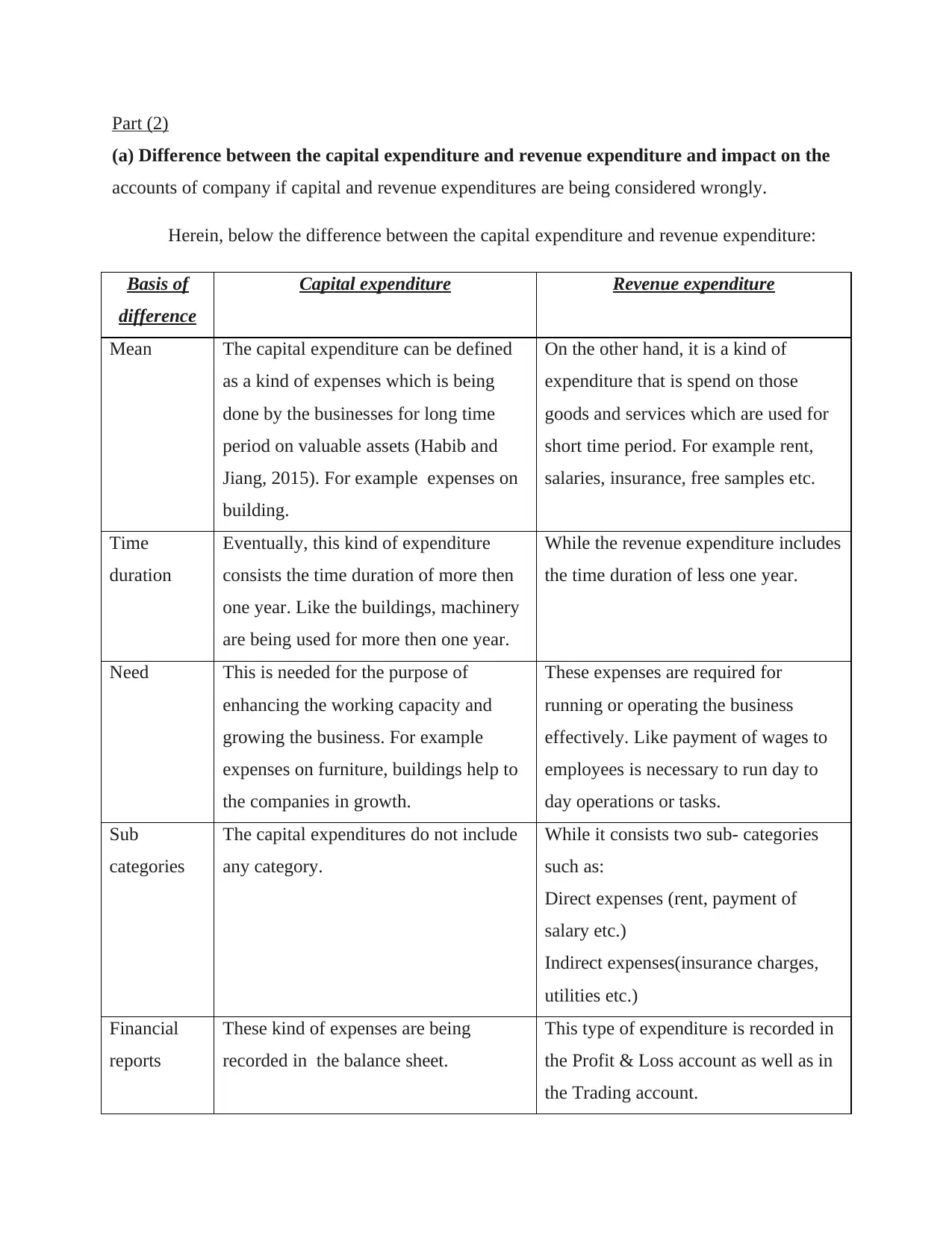
Part (2)
(a) Difference between the capital expenditure and revenue expenditure and impact on the
accounts of company if capital and revenue expenditures are being considered wrongly.
Herein, below the difference between the capital expenditure and revenue expenditure:
Basis of
difference
Capital expenditure Revenue expenditure
Mean The capital expenditure can be defined
as a kind of expenses which is being
done by the businesses for long time
period on valuable assets (Habib and
Jiang, 2015). For example expenses on
building.
On the other hand, it is a kind of
expenditure that is spend on those
goods and services which are used for
short time period. For example rent,
salaries, insurance, free samples etc.
Time
duration
Eventually, this kind of expenditure
consists the time duration of more then
one year. Like the buildings, machinery
are being used for more then one year.
While the revenue expenditure includes
the time duration of less one year.
Need This is needed for the purpose of
enhancing the working capacity and
growing the business. For example
expenses on furniture, buildings help to
the companies in growth.
These expenses are required for
running or operating the business
effectively. Like payment of wages to
employees is necessary to run day to
day operations or tasks.
Sub
categories
The capital expenditures do not include
any category.
While it consists two sub- categories
such as:
Direct expenses (rent, payment of
salary etc.)
Indirect expenses(insurance charges,
utilities etc.)
Financial
reports
These kind of expenses are being
recorded in the balance sheet.
This type of expenditure is recorded in
the Profit & Loss account as well as in
the Trading account.
(a) Difference between the capital expenditure and revenue expenditure and impact on the
accounts of company if capital and revenue expenditures are being considered wrongly.
Herein, below the difference between the capital expenditure and revenue expenditure:
Basis of
difference
Capital expenditure Revenue expenditure
Mean The capital expenditure can be defined
as a kind of expenses which is being
done by the businesses for long time
period on valuable assets (Habib and
Jiang, 2015). For example expenses on
building.
On the other hand, it is a kind of
expenditure that is spend on those
goods and services which are used for
short time period. For example rent,
salaries, insurance, free samples etc.
Time
duration
Eventually, this kind of expenditure
consists the time duration of more then
one year. Like the buildings, machinery
are being used for more then one year.
While the revenue expenditure includes
the time duration of less one year.
Need This is needed for the purpose of
enhancing the working capacity and
growing the business. For example
expenses on furniture, buildings help to
the companies in growth.
These expenses are required for
running or operating the business
effectively. Like payment of wages to
employees is necessary to run day to
day operations or tasks.
Sub
categories
The capital expenditures do not include
any category.
While it consists two sub- categories
such as:
Direct expenses (rent, payment of
salary etc.)
Indirect expenses(insurance charges,
utilities etc.)
Financial
reports
These kind of expenses are being
recorded in the balance sheet.
This type of expenditure is recorded in
the Profit & Loss account as well as in
the Trading account.
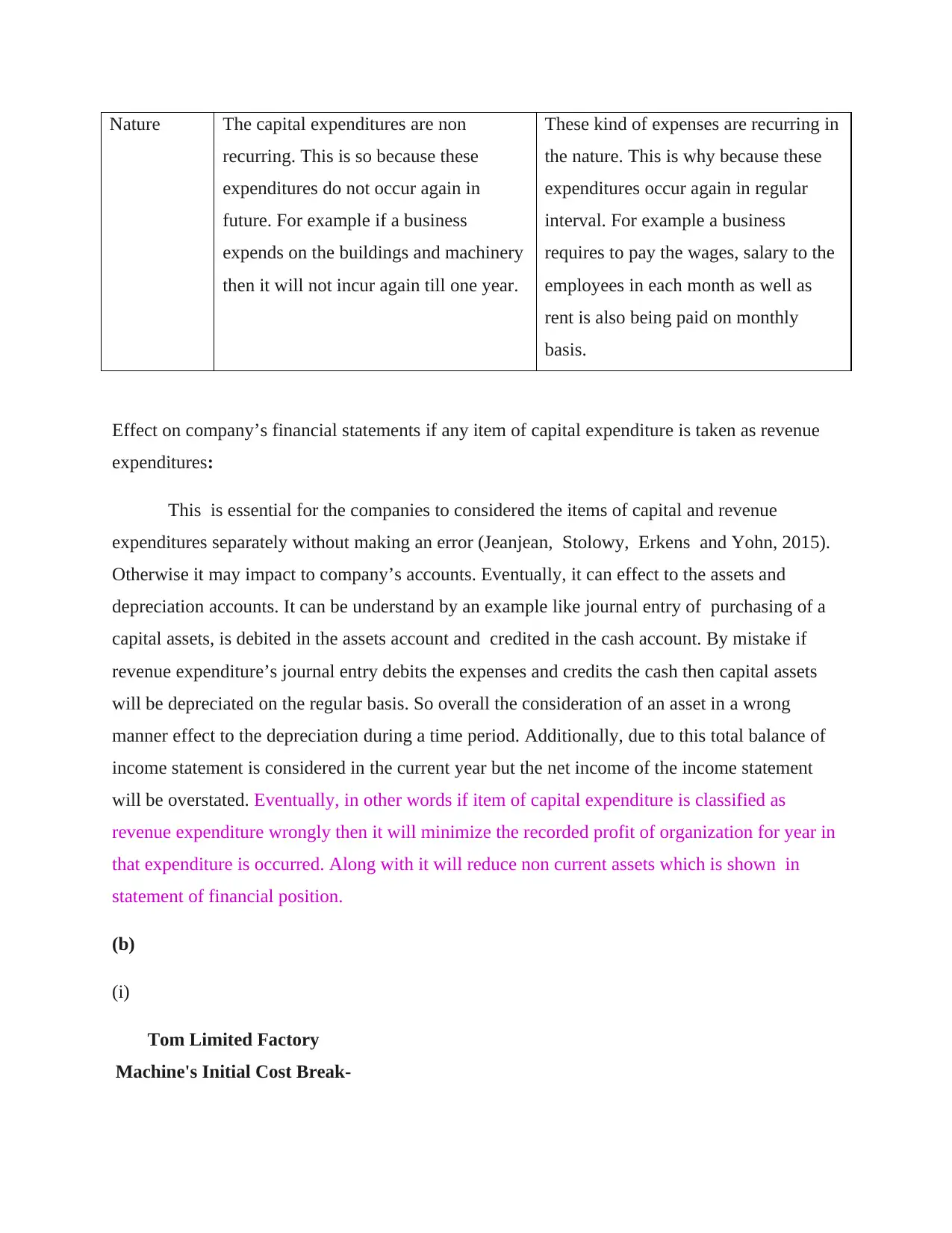
Nature The capital expenditures are non
recurring. This is so because these
expenditures do not occur again in
future. For example if a business
expends on the buildings and machinery
then it will not incur again till one year.
These kind of expenses are recurring in
the nature. This is why because these
expenditures occur again in regular
interval. For example a business
requires to pay the wages, salary to the
employees in each month as well as
rent is also being paid on monthly
basis.
Effect on company’s financial statements if any item of capital expenditure is taken as revenue
expenditures:
This is essential for the companies to considered the items of capital and revenue
expenditures separately without making an error (Jeanjean, Stolowy, Erkens and Yohn, 2015).
Otherwise it may impact to company’s accounts. Eventually, it can effect to the assets and
depreciation accounts. It can be understand by an example like journal entry of purchasing of a
capital assets, is debited in the assets account and credited in the cash account. By mistake if
revenue expenditure’s journal entry debits the expenses and credits the cash then capital assets
will be depreciated on the regular basis. So overall the consideration of an asset in a wrong
manner effect to the depreciation during a time period. Additionally, due to this total balance of
income statement is considered in the current year but the net income of the income statement
will be overstated. Eventually, in other words if item of capital expenditure is classified as
revenue expenditure wrongly then it will minimize the recorded profit of organization for year in
that expenditure is occurred. Along with it will reduce non current assets which is shown in
statement of financial position.
(b)
(i)
Tom Limited Factory
Machine's Initial Cost Break-
recurring. This is so because these
expenditures do not occur again in
future. For example if a business
expends on the buildings and machinery
then it will not incur again till one year.
These kind of expenses are recurring in
the nature. This is why because these
expenditures occur again in regular
interval. For example a business
requires to pay the wages, salary to the
employees in each month as well as
rent is also being paid on monthly
basis.
Effect on company’s financial statements if any item of capital expenditure is taken as revenue
expenditures:
This is essential for the companies to considered the items of capital and revenue
expenditures separately without making an error (Jeanjean, Stolowy, Erkens and Yohn, 2015).
Otherwise it may impact to company’s accounts. Eventually, it can effect to the assets and
depreciation accounts. It can be understand by an example like journal entry of purchasing of a
capital assets, is debited in the assets account and credited in the cash account. By mistake if
revenue expenditure’s journal entry debits the expenses and credits the cash then capital assets
will be depreciated on the regular basis. So overall the consideration of an asset in a wrong
manner effect to the depreciation during a time period. Additionally, due to this total balance of
income statement is considered in the current year but the net income of the income statement
will be overstated. Eventually, in other words if item of capital expenditure is classified as
revenue expenditure wrongly then it will minimize the recorded profit of organization for year in
that expenditure is occurred. Along with it will reduce non current assets which is shown in
statement of financial position.
(b)
(i)
Tom Limited Factory
Machine's Initial Cost Break-
⊘ This is a preview!⊘
Do you want full access?
Subscribe today to unlock all pages.

Trusted by 1+ million students worldwide
1 out of 21
Related Documents
Your All-in-One AI-Powered Toolkit for Academic Success.
+13062052269
info@desklib.com
Available 24*7 on WhatsApp / Email
![[object Object]](/_next/static/media/star-bottom.7253800d.svg)
Unlock your academic potential
Copyright © 2020–2025 A2Z Services. All Rights Reserved. Developed and managed by ZUCOL.




